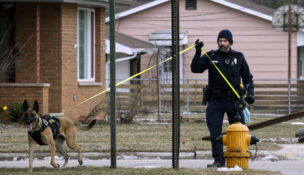Negligent bank not liable to subcontractors
By: dmc-admin//September 22, 2004//
 |
|
“The legislature has balanced the interests of lenders and subcontractors, and we respect that balance.” Hon. Charles P. Dykman |
The Wisconsin Court of Appeals held on Sept. 16 that it would contravene public policy to allow a subcontractor to recover in tort from the construction lenders for disbursing funds to the general contractor without obtaining lien waivers.
In October 1996, a corporation named The Villager at Nashotah entered into a construction loan agreement with M&I Midstate Bank to build four eight-unit apartment buildings in Plover.
The agreement called for M&I to lend a total of $1.32 million to The Villager, secured by four real estate mortgages. The loan agreement stated that M&I “shall not be responsible for any aspect of the [c]onstruction … or the procurement of lien waivers.”
An M&I vice president, Thomas Domaszek, was the loan officer for the project, and the disbursing agent on the project was McDonald Title Co., Inc., owned by Robert McDonald.
The Villager hired Packard Con-struction, Inc., as the general contractor. Packard then subcontracted with Hoida, Inc., for prefabricated wooden wall sections and roof trusses.
Packard submitted and received draw requests without obtaining lien waivers. Domaszek testified that it was contrary to M&I’s usual practice to authorize the payment of draws before receiving lien waivers on previous draws. M&I’s failure to obtain lien waivers was also contrary to its internal procedures, standards within the lending industry, and accepted practice in Portage County.
The draws were not being used to finance construction, but were being misappropriated by a principal of the Villager, Michael Imperl. M&I ultimately foreclosed on the Villager’s mortgages. Hoida also obtained a judgment against the Villager and its guarantors. However, while M&I recovered its losses, Hoida remains unpaid, and estimates that it is owed $548,175.68
Hoida sued M&I and McDonald in tort. All parties moved for summary judgment, agreeing that the issue was whether M&I and McDonald, in their respective capacities on the Villager project, owed any duties to Hoida. Portage County Circuit Court Judge Lewis Murach held that the defendants owed no duty to Hoida, and granted summary judgment on that basis.
Hoida appealed, but the court of appeals affirmed, in a decision by Judge Charles P. Dykman, but on different grounds.
The court began by stating, “In Wisconsin, everyone owes a duty to all others to refrain from any act that will cause foreseeable harm to others,” citing Dixson v. WI Health Organization Ins. Corp., 2000 WI 95, 237 Wis.2d 149, 612 N.W.2d 721.
|
What the court held Case: Hoida, Inc. v. M&I Midstate Bank, No. 03-2108. Issue: Does a bank owe a duty to a subcontractor to obtain lien waivers before disbursing funds to a general contractor? Do public policy considerations bar tort liability on the bank’s part for failing to do so? Holding: Yes. Everyone in Wisconsin owes a duty to everyone else to refrain from acts that can cause foreseeable harm. Yes. The legislature has enacted a comprehensive statutory scheme regulating construction loans, and deference to the legislature requires that the balance of competing interests it has adopted be respected. Counsel: Scott R. Halloin, Milwaukee, for appellant; Russell T. Golla, Stevens Point; Gary L. Dreier, Stevens Point; William J. Ewald, Green Bay, for respondent. |
The court continued, “The circuit court concluded that M&I and McDonald did not owe Hoida a duty. We disagree. Wisconsin courts rarely limit liability under a duty analysis. See Gritzner, 235 Wis. 2d 781, par. 24 n.4. Rather, courts more often limit liability by applying public policy factors. Id. “The consistent analyses of [the Wisconsin Supreme Court] reveal that the question of duty is not an element of the court’s policy determination. It is, rather, an ingredient in the determination of negligence.” A.E. Investment Corp., 62 Wis.2d at 484.”
The court noted that the circuit court limited liability because it did not want to extend the law of negligence into a commercial environment for which state statutes established a scheme creating its own rights and obligations. Rejecting this approach, however, the court of appeals concluded, “These may be valid policy reasons to limit M&I and McDonald’s liability. But duty is a broad concept in Wisconsin, and usually does not limit a plaintiff’s recovery.”
Addressing that duty, the court held, “M&I and McDonald owed Hoida the obligation ‘to refrain from any act which [would] cause foreseeable harm to Hoida.’ Here, the act (or failure to act) was the failure to procure lien waivers. M&I and McDonald witnesses stated that obtaining lien waivers was the industry standard, and that this was the usual practice of M&I and McDonald. Domaszek averred that it was inconsistent with M&I’s policy to pay draws when lien waivers had not been obtained on previous draws. Robert McDonald averred that in Portage County, lien waivers are customarily obtained by disbursing agents before the funding of the next draw request. McDonald also averred that the guidelines and procedures of the insurance manual governing the title insurance issued f
or the project stated that ‘we should make every effort to obtain [lien] waivers in full wherever possible.’ It was foreseeable that the failure to obtain lien waivers could harm subcontractors, including Hoida. Therefore, we conclude that M&I and McDonald owed Hoida a duty of care (cites omitted).”
Proceeding to the second standard element of negligence analysis — breach — the court noted that the defendants admitted that, if there was a duty, they breached it by not obtaining lien waivers.
The court also found the third element — substantial causation — to be met, because, “Had M&I and McDonald not funded draws after Packard failed to supply lien waivers, Packard and Imperl could not have diverted the draws. As a result, the project would have most likely come to a halt, and Hoida would not have furnished material for which it was not paid. M&I and McDonald’s failure to obtain lien waivers meets the substantial factor test (footnote omitted).”
Finally, the court noted that no party disputed that Hoida “is out several hundred thousand dollars,“ and therefore, suffered damage, meeting the fourth element of negligence analysis. Having found the four elements necessary to establish a negligence claim, the court turned to whether public policy should bar recovery, citing the six non-exclusive public policy factors set forth in Fandrey v. American Family Mut. Ins. Co., 2004 WI 62, 680 N.W.2d 345: (1) the injury is too remote from the negligence; (2) the injury is too wholly out of proportion to the tortfeasor’s culpability; (3) in retrospect it appears too highly extraordinary that the negligence should have resulted in the harm; (4) allowing recovery would place too unreasonable a burden on the tortfeasor; (5) allowing recovery would be too likely to open the way for fraudulent claims; and (6) allowing recovery would enter a field that has no sensible or just stopping point.
In considering those factors, the court noted that Chapter 779 of the statutes provides rights and remedies to subcontractors and material suppliers, with one of the purposes of that chapter being to ensure payment of subcontractors. Nevertheless, under the scheme, lenders have priority lien status over subcontractors. Secs. 799.01(4), 706.11(1).
| |
||
|
Related Links Related Article |
||
| |
||
The court acknowledged that Hoida has a legitimate argument that the statutory scheme creates iniquities, repeating Hoida’s argument as follows: “Hoida asserts that this scheme creates a perverse incentive for lenders not to notify subcontractors when they encounter problems or risks with a contractor. If the lender contacts the subcontractor to inform it of potential difficulties, the subcontractor may stop working and file a lien, jeopardizing the lender’s security. If the lender does nothing, the subcontractor will continue to work, thereby increasing the lender’s security for repayment. Hoida observes that this increases the likelihood that the subcontractor will shoulder the loss.”
Nevertheless, the court refused to create a tort remedy for this problem, stating, “Under Wis. Stat. ch. 779, the legislature made a policy choice to provide protection to subcontractors and material suppliers on construction projects. It also elected, under Wis. Stat. §§ 779.01(4) and 706.11, to limit that protection in certain situations by providing priority status to lenders. Establishing for Hoida a new claim against M&I and McDonald would contravene the public policy choices of the legislature.”
The court noted that Hoida could have protected itself by filing a lien, but failed to do so. While filing a lien would not guarantee payment, the court concluded, “the legislature has balanced the interests of lenders and subcontractors, and we respect that balance.”
Accordingly, the court affirmed.
Click here for Case Analysis.
David Ziemer can be reached by email.
Legal News
- Wisconsin Supreme Court justices question how much power Legislature should have
- Milwaukee’s Common Council now has the most African Americans, women and openly LGBTQ members ever
- Office of School Safety Provides Behavioral and Threat Assessment Management Training Ahead of 25th Anniversary of Columbine Shooting
- Wisconsin Supreme Court to hear arguments in Democratic governor’s suit against GOP-led Legislature
- Lawsuit asks Wisconsin Supreme Court to strike down governor’s 400-year veto
- Wisconsin man pleads not guilty to neglect in disappearance of boy
- ACS Selects University of Wisconsin Law School’s Miriam Seifter for 2024 Ruth Bader Ginsburg Scholar Award
- People with disabilities sue in Wisconsin over lack of electronic absentee ballots
- Wisconsin Republicans ignore governor’s call to spend $125M to combat ‘forever chemicals’
- Native American voices are finally factoring into energy projects
- Steven Avery prosecutor Ken Kratz admits ‘mistakes were made’
- Colombian national extradited to Milwaukee faces International narcotics-trafficking conspiracy charge
WLJ People
- Power 30 Personal Injury Attorneys – Russell Nicolet
- Power 30 Personal Injury Attorneys – Benjamin Nicolet
- Power 30 Personal Injury Attorneys – Dustin T. Woehl
- Power 30 Personal Injury Attorneys – Katherine Metzger
- Power 30 Personal Injury Attorneys – Joseph Ryan
- Power 30 Personal Injury Attorneys – James M. Ryan
- Power 30 Personal Injury Attorneys – Dana Wachs
- Power 30 Personal Injury Attorneys – Mark L. Thomsen
- Power 30 Personal Injury Attorneys – Matthew Lein
- Power 30 Personal Injury Attorneys – Jeffrey A. Pitman
- Power 30 Personal Injury Attorneys – William Pemberton
- Power 30 Personal Injury Attorneys – Howard S. Sicula











